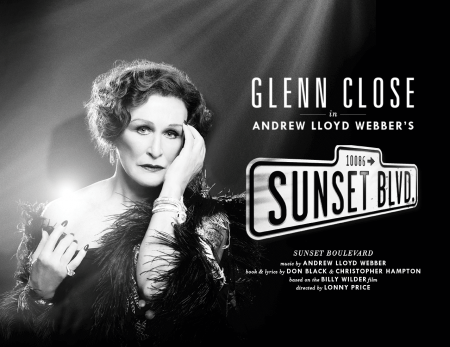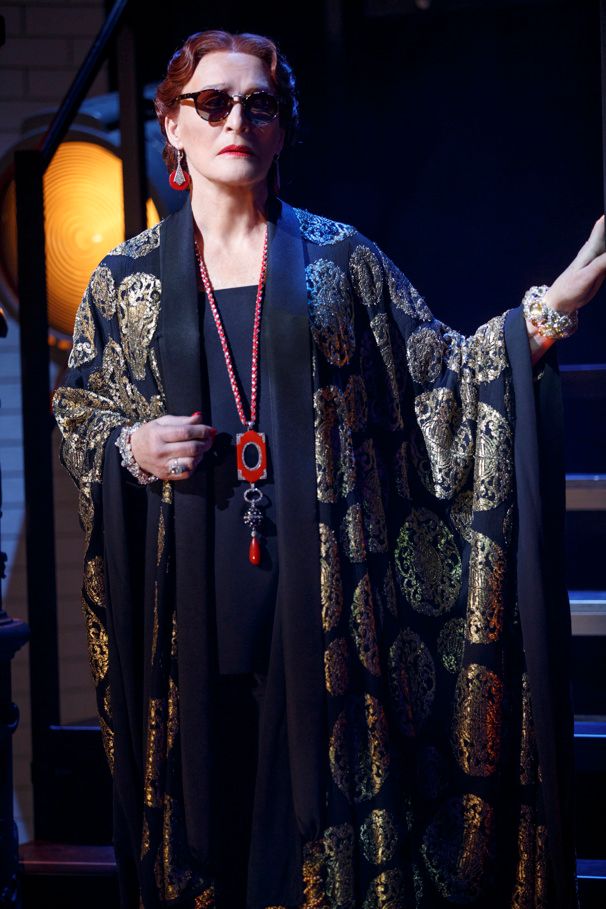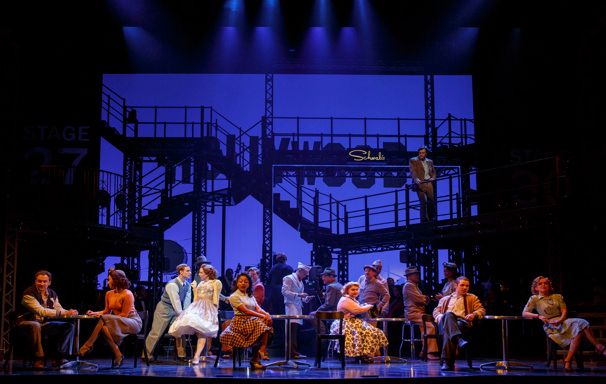Last night at a performance of the “Sunset Boulevard” revival at the Palace Theater, Hillary Clinton arrived and received a standing ovation. However, from that moment on the spotlight (literally) was turned away from Hillary Clinton and onto Glenn Close, who once again dazzles as the faded silent-film diva Norma Desmond. Very infrequently do actors step back into roles they have already played—let alone conquered. In 1994 Close won a Tony award for her performance, and now 22 years later she has tackled the part once again, glittering more than ever in one of the most campy, comic, iconic, and devastating roles of all time.
This revival of Sir Andrew Lloyd Webber’s “Sunset Boulevard,” directed by Lonny Price, was set for a very brief limited engagement, but just this week announced an extension through the end of June. Ever since Glenn Close made her final exit as Norma, audiences have been dying for a return, and now that she’s back they want to see her as much as they can.
The tricky thing about revivals is that audiences go see them because they loved the original so much, but it is the duty of the director, designers, and actors to take an old piece and make it new. When it comes to a musical as iconic as “Sunset Boulevard” the stakes were high: the fans are devout and they know every line, every costume, and they don’t want to be let down.
Thank God the production did not disappoint.
This revival certainly made a large number of changes but did so in a way that was so elegant, respectful, purposeful, and conscious of the original that no die-hard fan could leave upset. The most notable changes include the expanded 40-piece orchestra—one of the largest in Broadway history—that was located onstage and the extremely pared-down, deconstructed sets (designed by James Noone) made of only scaffolding and metal staircases. Although both of these changes can seem blasphemous, they worked beautifully, stripping the show of excess and making Norma seem like the only glitter left in an industrial world. The costumes were a conscious recognition of the devoutness of the fans: Norma’s costumes were the originals by Anthony Powell, but everyone else had new designs by Tracey Christensen. After all, there are some things you just can’t change: the art deco gowns, coats with trains of ostrich feathers, the over-sized fur cuffs, and the never ending diamonds, for example. The production frequently lowered down a screen and projected scenes from vintage Hollywood, transforming the audience watching a musical in 2017 to an audience watching the films of yesteryear.
Audience members are only able to focus on these new scenographic elements for the first few moments of the show, for when Glenn Close first saunters down the staircase, the rest of the world stops. The majority of the lead actors were transferred from the West End production where this revival began, and they are certainly nothing to talk about. Maybe in another play, Michael Xavier (as Joe), Siobhan Dillon (as Betty), and Fred Johanson (as Max) would have given audience more to talk about, but next to Glenn Close they all seemed flat. The same can be said of the over-sized ensemble and their lackluster choreography by Stephen Mears. After all, “Sunset Boulevard” is basically the Norma Desmond show; the only reason she isn’t in every scene is to make the audience appreciate her more and to wait in ecstasy for her next entrance.
It has been 22 years since Glenn Close last played this role, but now she has much more wisdom and life experience; her performance this time around is much more nuanced, fragile, fierce, and most of, magnetic. The entire musical orbits around her as she rules over it. Close put in a lot of work in reprising this part, which she wanted to perform very differently; she didn’t want to “go back” to the role but wanted to find a new Norma. In an interview, Close said, “It’s a luxury to go back to Norma Desmond, who I think is one of the best roles ever written for a woman.” She absolutely makes the most of this second chance and it is clear how honored she is to return home.
In her most famous song, “As If We Never Said Goodbye,” Norma returns to the Paramount Pictures lot amidst the filming for Cecile B. DeMille’s latest film. She is quickly recognized and everyone stops what they’re doing and stares at her as she sings a ballad about a return to the place that she loves. As she belts out her final notes, the entire ensemble applauds her, still in awe of the stunning celebrity of a bygone era. In one of the most touching moments of metatheatricality, the audience at the Palace Theater feels the same way about Glenn Close as the ensemble onstage does about Norma Desmond. Everyone is so excited and overjoyed to see her again, looking amazing and sounding beautiful, performing as if we never said goodbye.
But it is her Act I finale “The Perfect Year” in which she tries to convince Joe to permanently move in with her and be her lover that the most subtle directorial choice is made. Throughout the show an actress plays a shadow Norma in her youthful prime, dressed in an all black ensemble, a haunting reminder of what used to be. During the emotional New Year’s Eve song, Norma dances with Joe as the shadow Norma watches, and in one beautiful moment the two Norma’s switch; Joe dances with the young, beautiful, famous Norma and is in love. It is here that the audience begins to understand Joe’s attraction to Norma: he doesn’t love Norma, the person but the icon who she used to be. We can all relate—after all, it’s the whole reason we’ve come to see this revival.
“Sunset Boulevard” is a battle between Glenn Close and the rest of the show, and unsurprisingly she wins (the lush and haunting orchestra is her only close competitor). Just like Norma Desmond, Glenn Close is giving us all new ways to dream and all we can do is be thankful and keep seeing the show again and again, desperate for one more look.








